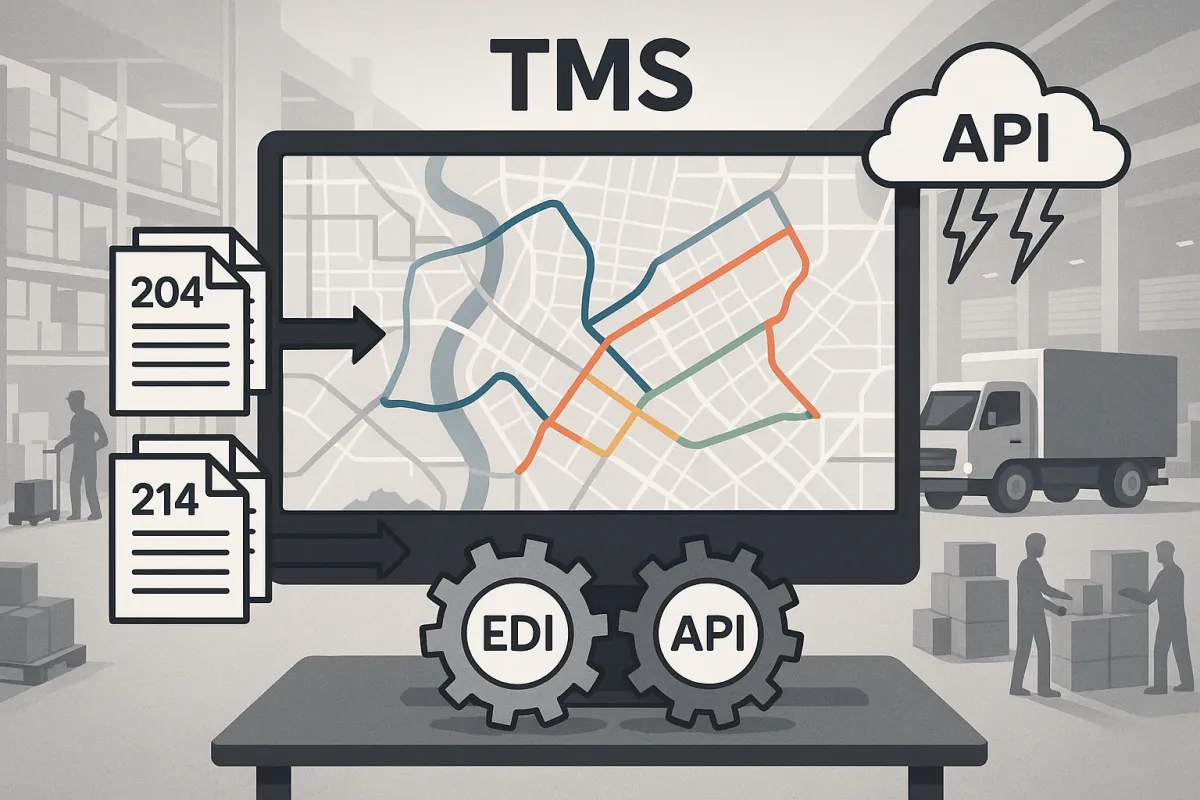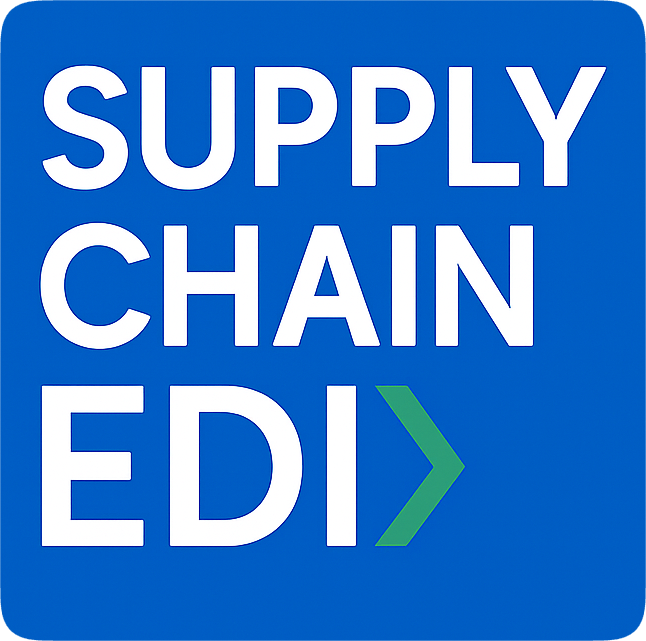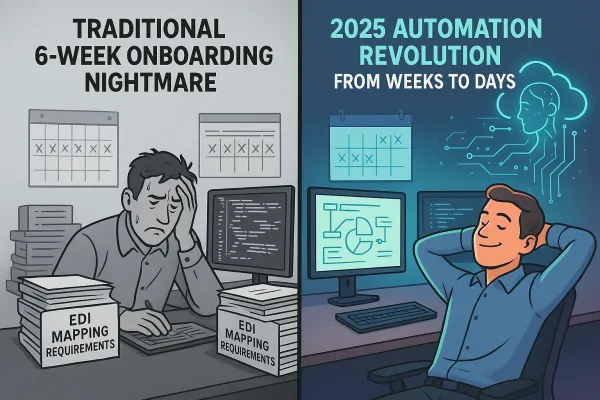The Complete TMS Integration Strategy Guide: How to Choose Between EDI, API, and Hybrid Approaches for Maximum Supply Chain Efficiency in 2025

Transportation companies face a tough decision. Thousands of businesses operating in the industry continue to rely on electronic data interchange (EDI) for all their integration needs. Meanwhile, APIs promise real-time data exchange and rapid implementation. Yet for freight brokers, shippers, and carriers to know how TMSs integrate with legacy systems and new platforms, they need to understand the technology behind such integrations. The answer isn't choosing one over the other but finding the right mix for your specific needs.
Understanding the Core Differences: EDI vs API in Transportation Context
Here's the fundamental difference: EDI bundles orders, invoices, and shipment notices into standard file formats like X12 and UN/EDIFACT. Because the files move on a fixed schedule, updates can take hours to reach the next system. APIs work differently. With cloud-based solutions, API allows transportation management systems (TMS) to transmit data in less than a second.
The speed difference matters when you're managing freight operations. This allows a transportation management system (TMS) to run on real-time data, whether you're getting tracking updates, building loads or getting spot quotes. That's particularly valuable for spot market pricing, where rates change hourly.
When EDI Excels in Transportation
EDI is a great way to streamline the transportation management system because it minimizes labor and eliminates irregularities like illegible handwriting or various forms of human error. This technology can send a large volume of information at once, and it typically aids SQL integration with legacy systems.
For transportation companies, EDI handles the heavy lifting on standardized documents. EDI 204 (Motor Carrier Load Tender) is an X12 transaction set that shippers or other parties use to tender a shipment to full-load motor carriers. It includes shipping instructions, schedule details, equipment requirements, and commodities apposite a load tender. Similarly, EDI 214 (Transportation Carrier Shipment Status Message) is an X12 transaction set that transportation carriers use to send shipment statuses, including time, date, location, route, identification numbers, and conveyance, to the shippers, consignees, and other parties.
EDI also shines in compliance-heavy environments. EDI is often used for batch processing, where a set of transactions is exchanged periodically. This can be suitable for certain types of trucking transactions, such as invoices, shipping notices, and purchase orders.
Where APIs Shine for Modern TMS
APIs will expand a company's ability to automate manual pieces of their business that cannot be offered through EDI connections. For example, requesting spot quotes through an API can eliminate hundreds of calls and emails that take place on a weekly basis.
APIs excel at dynamic, interactive tasks. APIs allow for real-time data exchange, enabling instant communication between systems. This can be advantageous for real-time tracking, route optimization, and dynamic decision-making. When a driver's ETA changes due to traffic, APIs update all stakeholders immediately rather than waiting for the next EDI batch.
APIs are more flexible than EDI as they don't rely on rigid document standards. They can handle various data formats, including JSON and XML, and are more adaptable to changes in business processes.
The Hybrid Approach: Why Both Technologies Matter
The smartest transportation companies aren't choosing between EDI and API. They're using both strategically. The best solution is EDI and API integration. EDI and web-based API solutions can combine on one platform to provide trading partners with a more comprehensive approach to B2B information exchange.
Here's how hybrid strategies work in practice: inventory-centric documents (943, 856, 945, 846) keep riding EDI until your ERP and trading partners are ready for a broader API leap. Status updates and appointment scheduling move to APIs for instant visibility. The core documents stay on proven EDI rails.
EDI and web service APIs can work together seamlessly and complement each other on one platform. Real-time (API) and file-based batch (EDI) processes complement each other seamlessly when these processes are running on the same platform and can interact with each other.
This approach addresses a key business reality: The challenge is gaining API speed without breaking the EDI links your partners rely on. EDI may be rusty technology, but everyone trusts it.
TMS Vendor Analysis: Integration Capabilities Comparison
Major TMS providers handle EDI-API integration differently. Verst Logistics chose Cleo Integration Cloud for all EDI and API needs, leading to ability to say "yes" to more of API requirements and EDI mandates, all while lowering their error rate from 4% to 0.24%. That's the kind of improvement you see with unified platforms.
Cloud-native TMS platforms like MercuryGate's developers tailored this cloud-native TMS platform for SMBs ready to move beyond basic shipping tools like Pacejet or ShipStation. Its modern architecture and intuitive interface make it especially appealing to direct-to-consumer (DTC) and consumer packaged goods (CPG) companies looking for a scalable solution that aligns with cloud-first ERP systems like NetSuite or Acumatica.
For companies prioritizing flexibility, solutions like Cargoson offer balanced approaches alongside providers like Descartes, Transporeon, and nShift. The key is finding platforms that don't force you to choose between technologies but enable you to use each where it adds the most value.
Kleinschmidt's expertise in EDI and API integrations, paired with PCS's all-in-one TMS platform, delivers a seamless integration experience for fleets. Together, they ensure carriers can: Meet Shipper Requirements: Whether it's EDI, API, or hybrid systems, this partnership makes compliance effortless. That's the kind of vendor partnership that reduces integration headaches.
Implementation Challenges and Solutions
Regardless of which route a transportation company takes when choosing between EDI, API or using both across different customers, setting them up and executing maintenance and updates can be a challenge. The complexity multiplies when you're managing different protocols for different partners.
EDI setup traditionally requires more upfront work. EDI integrations may take several months, whereas, API integrations can take a matter of weeks, if not days, and files may have complex formats requiring the labor of specialists. However, modern EDI platforms are changing this equation.
The talent shortage complicates matters. According to Stack Overflow, the most readily available talent pool consists of API programmers. It is unrealistic to expect modern developers to learn traditional EDI methods unless there are compelling reasons to keep them engaged long-term. EDI developers are becoming increasingly scarce, and asking them to customize EDI processes beyond their regular integration tasks can create additional challenges.
The solution? Look for platforms that abstract the complexity. Start with foundational EDI and API integration automation, and grow into true supply chain orchestration. Cleo's powerful AI-integrated platform seamlessly digitalizes, automates, and orchestrates your entire EDI integrations and workflows, from the first purchase order to the final invoice.
The Decision Framework: Choosing Your Integration Strategy
Three criteria determine your optimal integration mix: partner readiness, system capabilities, and compliance requirements.
Partner readiness means evaluating whether your carriers and customers can handle API connections or need traditional EDI. Business Wire reports that 65% of organizations use APIs, while Global News Hire reports that 60% to 80% use EDIs. Your partner mix determines your technology requirements.
System capabilities matter more than you think. In today's world, most modern systems, such as ERP, WMS, or financial software, interact through APIs. Integrating your systems with an API-based EDI platform ensures streamlined workflows. If your internal systems are API-first, forcing everything through traditional EDI creates unnecessary translation layers.
Compliance comfort varies by industry. Maybe one day, but some industries may find it harder than others to make the change. Healthcare and finance may continue to rely on EDI for audit compliance for years. Transportation sits somewhere in the middle - regulated but not as strictly as healthcare.
ROI calculations should include implementation speed, ongoing maintenance costs, and error rates. API implementation may be less costly than EDI by not requiring on-going maintenance or translation services. However, those benefits may be offset by the increased complexity of adding new trading partners and collaborating on communication standards.
Future-Proofing Your Integration Strategy
The integration landscape is evolving rapidly. In fact the EDI software industry gets bigger every year. Programs like Amazon's Vendor Central rely on it, though many partners now add APIs for faster status calls. This suggests a future where EDI handles core documents while APIs manage real-time interactions.
There is a growing trend of cloud EDI API software designed for today's developers. Organizations like Amazon and Walmart are increasingly utilizing both API and EDI. While they have maintained EDI channels for years, they are now establishing parallel API channels for integrations as well.
AI integration is accelerating this trend. Modern platforms are incorporating AI-powered tools for predictive analytics, inventory optimization, and demand forecasting that analyze EDI transaction patterns while enabling real-time API responses.
The companies succeeding with this transition share a common approach: they start with proven EDI foundations and layer APIs where they add immediate value. A hybrid approach that blends the strengths of both APIs and EDI allows businesses to stay competitive, agile, and future-proof.
Transportation management doesn't require choosing between EDI and API. It requires choosing the right mix for your partners, systems, and growth plans. Start where your partners are today, but build platforms that can evolve as the industry modernizes.





